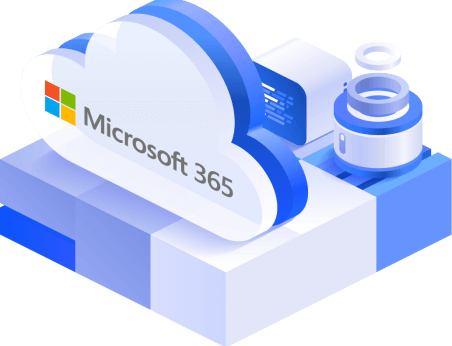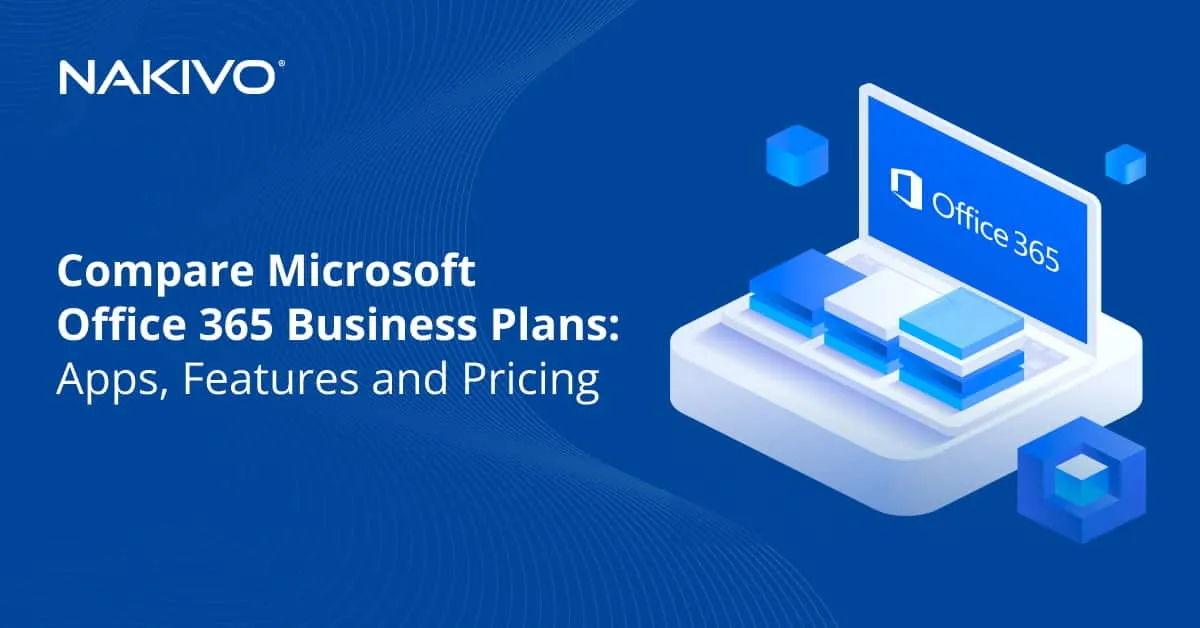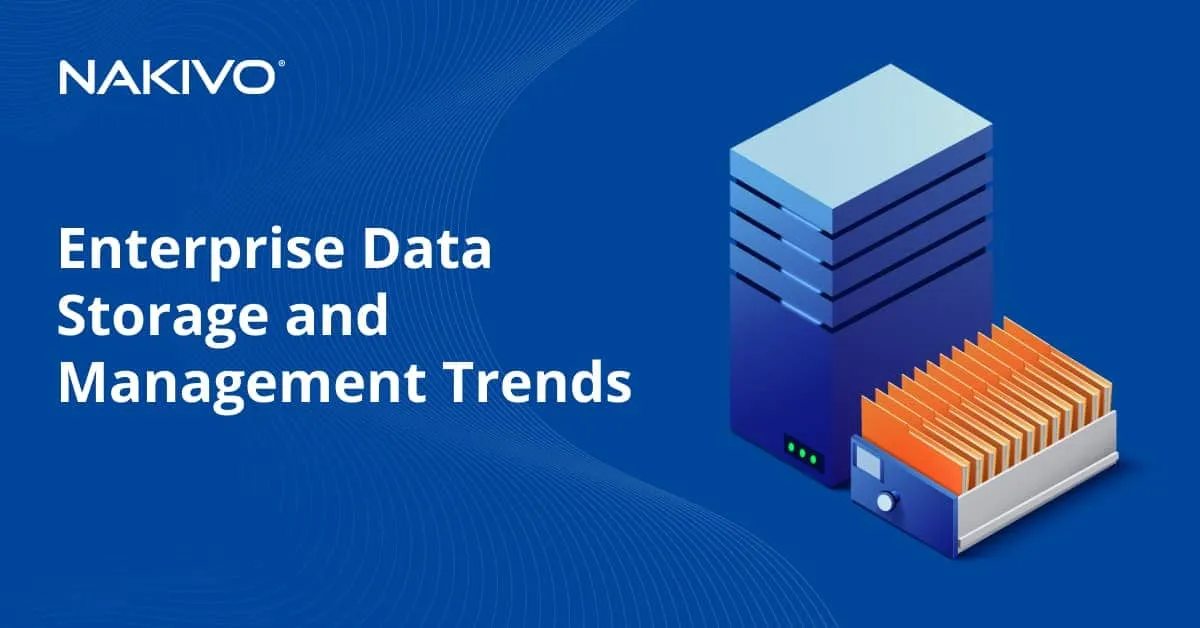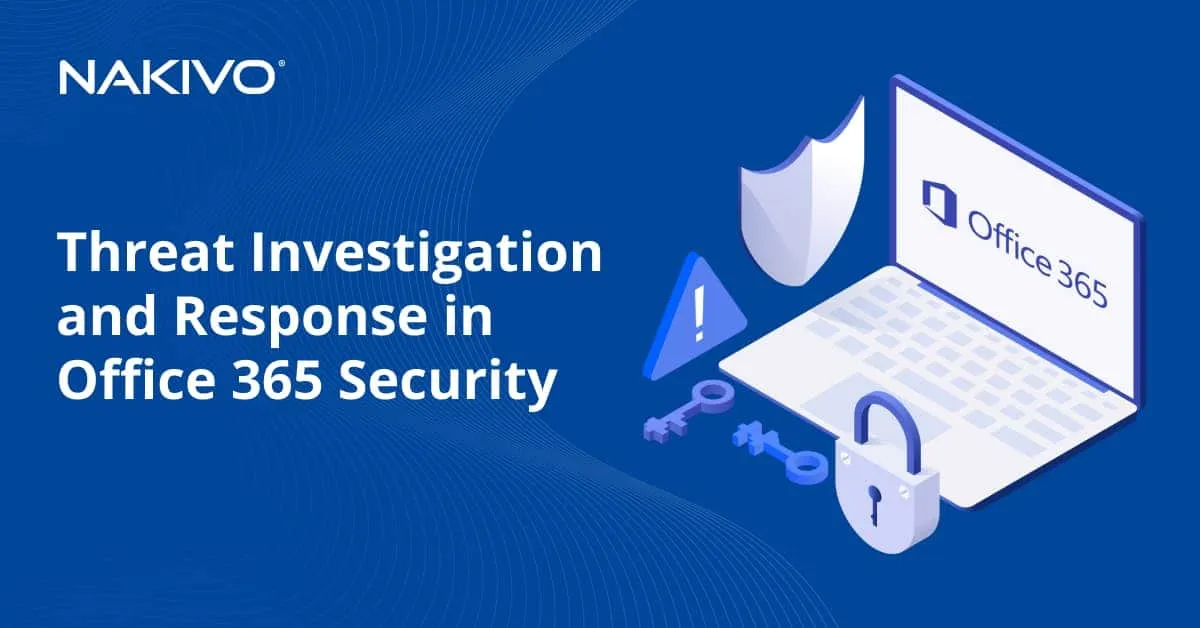SharePoint Online Central Administration: A Detailed Guide
As a collaboration platform, Microsoft SharePoint gives system administrators the tools they need to manage multiple users, the content in SharePoint, and other configuration settings in the SharePoint admin center. Read on to learn about how the admin center enables centralized management of SharePoint and discover the available actions.
What Is SharePoint Central Administration?
SharePoint central administration is where administrators perform administration tasks centrally for a SharePoint environment. It is divided into multiple parts and allows administrators to configure and manage SharePoint from a central location, including management of security, monitoring, general settings, system settings, and apps.
How do I find my SharePoint administrator?
A system administrator can be the SharePoint administrator in your organization, or your system administrator may know who is the SharePoint administrator and help you find the person responsible for SharePoint. If you have issues with SharePoint, for example, you don’t have enough permissions, you should ask your SharePoint administrator to resolve the issue.
How do I open SharePoint central administration?
You have the choice of two versions of SharePoint. You can either install SharePoint on your physical servers or virtual machines or use a cloud-based version of SharePoint (part of Office 365). Each central administration SharePoint portal is slightly different in this case.
When you install SharePoint on physical servers or VMs, a Central Administration site is created. Server administrator rights are required to access SharePoint central administration for standalone (on-premises) SharePoint deployments. Find a folder with SharePoint shortcuts in the Windows Start menu and open the SharePoint Central Administration tool (for example, SharePoint 2013 Central Administration). Run this file as an administrator. A link to access the web interface for SharePoint running on physical servers depends on your configuration.
When using SharePoint Online, SharePoint central administration is performed in a SharePoint admin center that is integrated with Office 365 management tools and admin centers. You can access a SharePoint admin center by clicking a link from the Office 365 admin center or by using a direct link. I will go into the details of using the SharePoint admin center below.
How to Use a SharePoint Admin Center
Go to https://admin.microsoft.com in your web browser to open the Office 365 admin center. Then in the navigation pane or in the list of all admin centers, click SharePoint to open a SharePoint admin center.
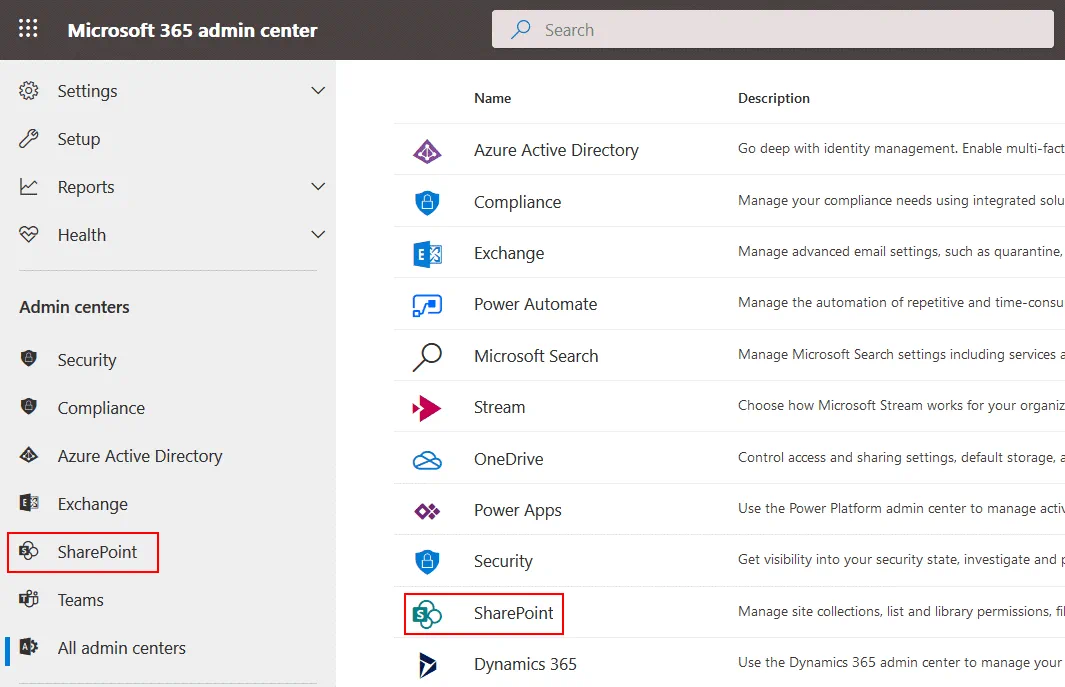
As an alternative, open a direct link to access a SharePoint admin center in Office 365, for example:
https://yourcompany-admin.sharepoint.com
where yourcompany is your company (tenant) name.
In my case, I will use the following link to access a SharePoint admin center in Office 365:
https://nakivo-admin.sharepoint.com
On the home page of the SharePoint admin center, you can see the file activity report, SharePoint site usage report for the last 30 days, service health, and message center. Hover over the chart to see the details for the appropriate point. Click Details near each graph to see more information for the last 7, 30, 90, or 180 days. Click the name of activity in the legend under the graph to reveal or hide the activity type on the graph. In the left pane (also called the navigation pane), you see the features and options that you can configure. In the bottom of the navigation pane, you can click Customize navigation to select the items you want to appear in the navigation pane.
A message center is used to notify the SharePoint administrator about improvements, new SharePoint features, and any changes that may affect SharePoint users. If you use SharePoint Online, all updates are installed automatically on servers running in the cloud (in Microsoft’s datacenters). If you click a message, the Office 365 admin center opens in a new tab to display detailed information. Hit All active messages to read all messages in the Office 365 admin portal.
The Service health section notifies you if any SharePoint Online services have been interrupted. Click View all services to check the status of all Office 365 services that are available in your subscription plan.
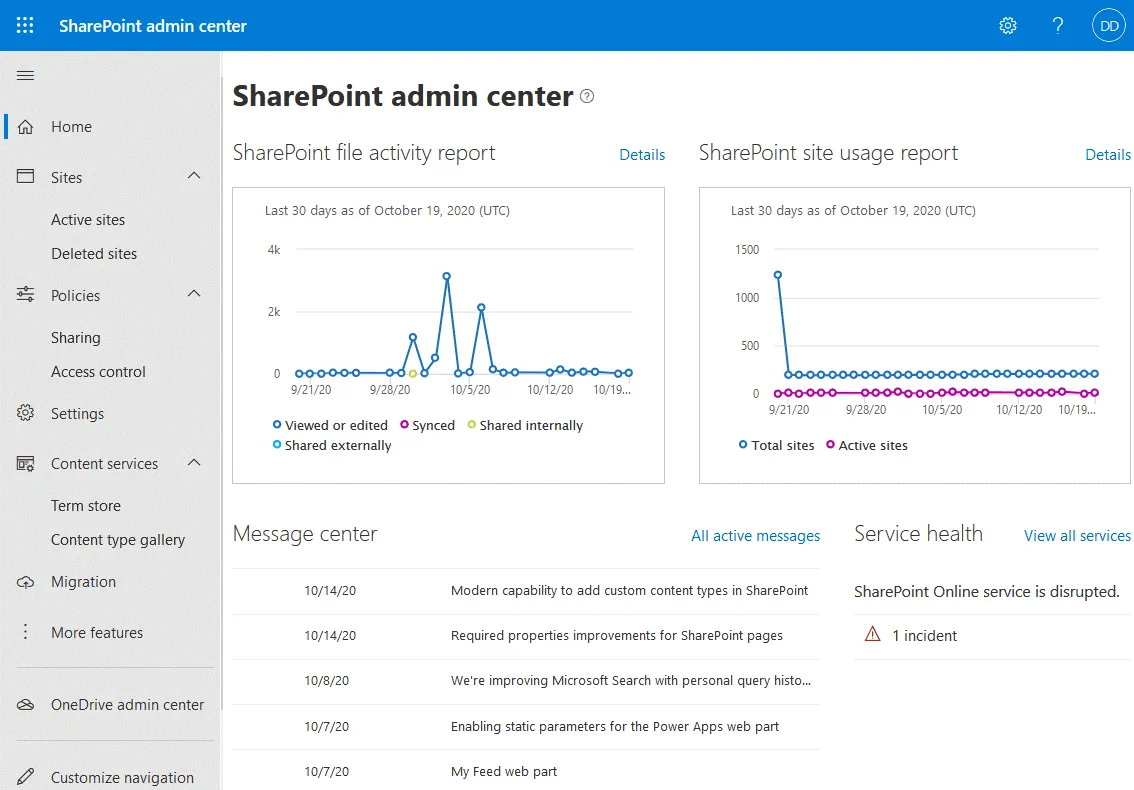
Sites
There are two sub-categories of sites: active sites and deleted sites.
Active sites. Use this page to manage all your sites. A list of active sites is displayed (with team sites and communication sites) including information about the site name, URL, storage usage, and primary admin. In the top right corner, there is a graph that indicates storage usage for all sites. There are two buttons to create a new site and export the active sites list to a CSV file. Active sites are sites where users view pages, download/upload files, and edit/modify files. Click the appropriate column header to sort a list by site name, URL, used storage, etc. Use the search field to find the needed site. Click the button located on the right of the search field to filter sites that you want displayed in the list.
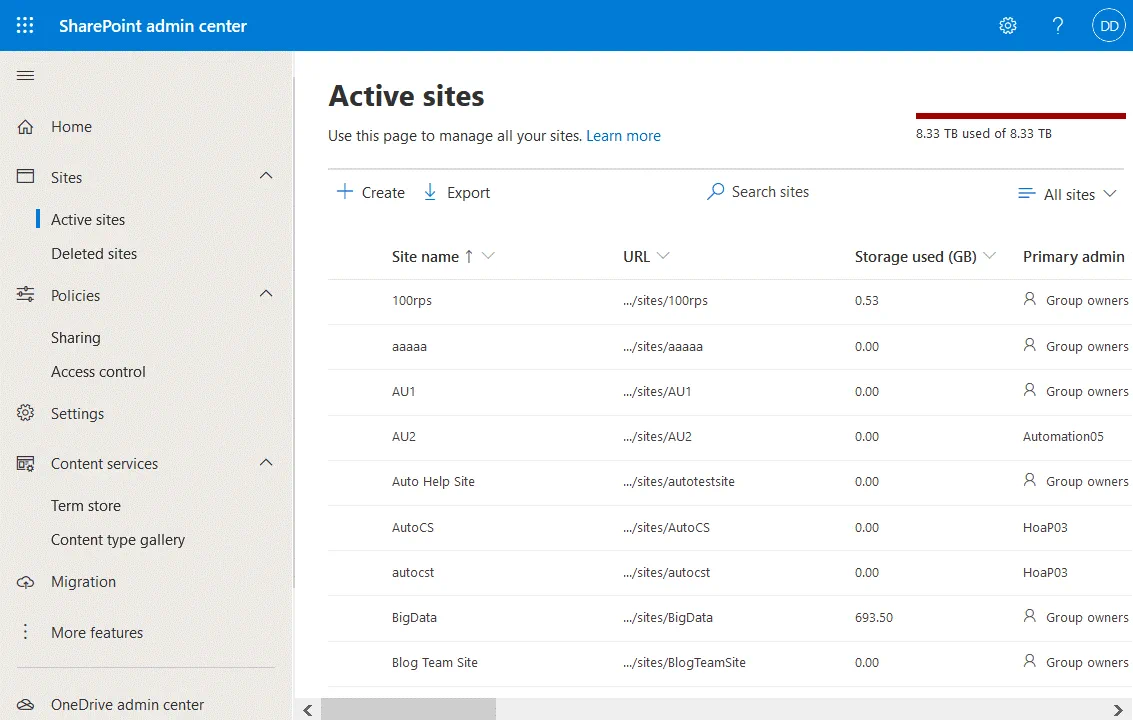
Click the site for which you want to edit options to open a window with site settings. There are four tabs: General, Activity, Permissions, and Policies. The General tab allows you to edit a site name and URL. The Activity tab shows information related to site activity and storage. In the Permissions tab, you can add/remove site admins and group owners. Use the Policies tab to edit site sharing policies and determine the users with whom content can be shared. These sharing settings are used to control sharing at the organization level and can be changed by a SharePoint administrator. Site owners cannot change these site sharing settings.
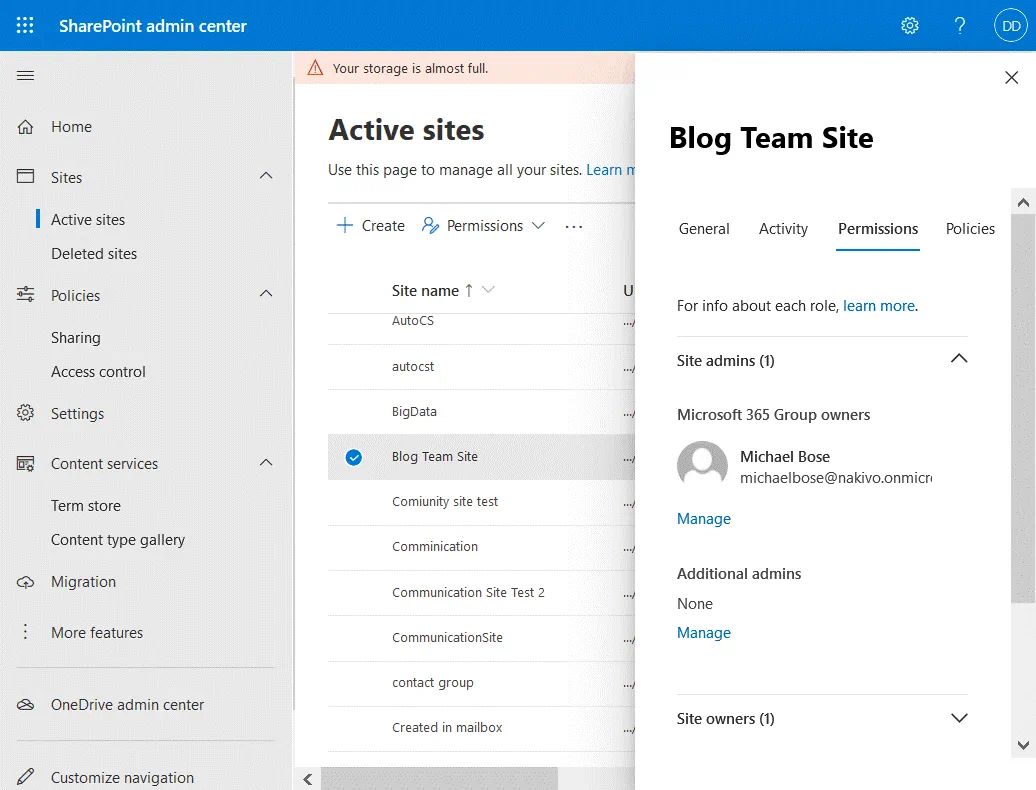
Deleted sites. On this page of the SharePoint admin center, the list of deleted SharePoint sites is displayed. A SharePoint administrator can restore a deleted site within a 93-day period. When 93 days have passed after site deletion, the site is deleted permanently. You can select a site in the list of deleted sites and hit Restore to restore the site or hit Permanently delete to delete the site permanently.
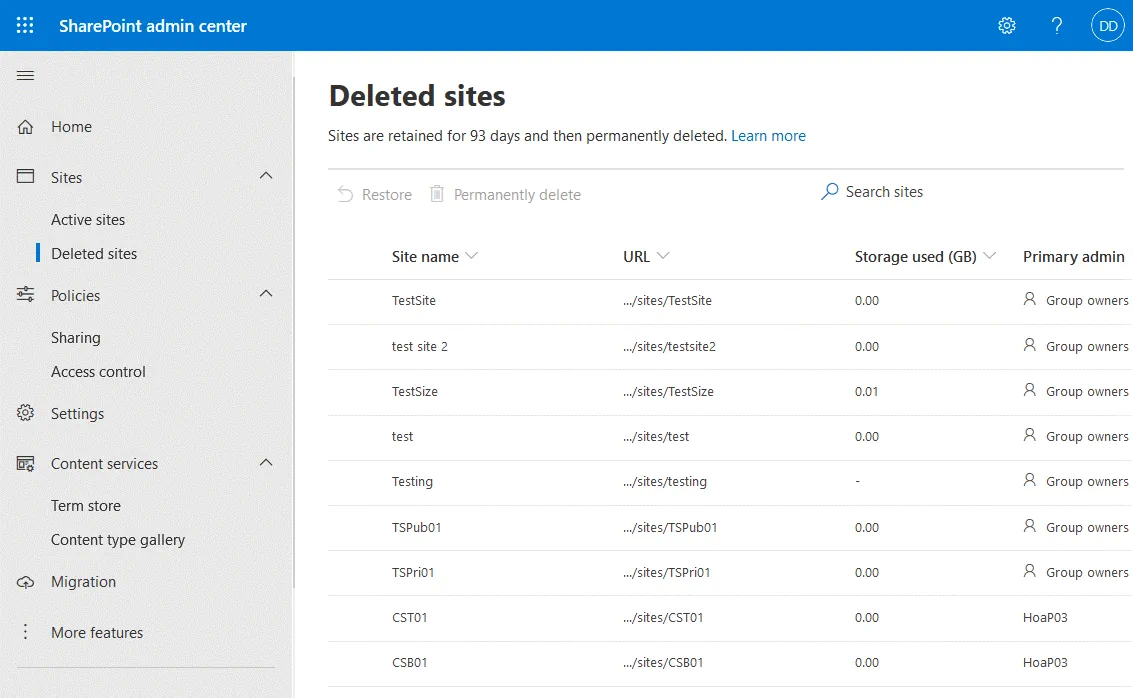
Policies
This section contains sharing policies and access control settings.
Sharing settings. These sharing settings are used to control sharing at the organization level in SharePoint and OneDrive. You can set settings from the least permissive to the most permissive. Four levels are available and content can be shared with:
- Anyone
- New and existing guests
- Existing guests
- Only people in your organization
A short explanation is available under each option for this page in the web interface of the SharePoint admin center. Let’s briefly look at all the settings on this page.
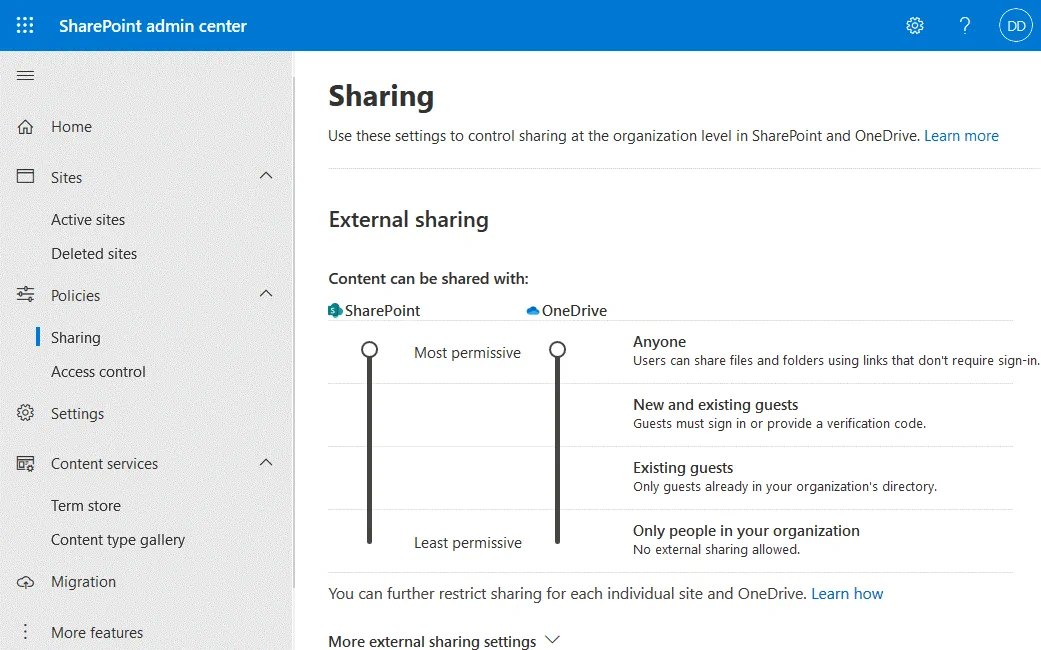
More external sharing settings
- Limit external sharing by domain (select domains from which users can/cannot access shared files)
- Allow only users in specific security groups to share externally
- Guests must sign in using the same account to which sharing invitations are sent
- Allow guests to share items they don’t own
- People who use a verification code must reauthenticate after this many days __
File and folder links
Choose the type of link that’s selected by default when users share files and folders in SharePoint and OneDrive
- Specific people (only the people the user specifies)
- Only people in your organization
- Anyone with the link
Choose the permission that’s selected by default for sharing links
- View
- Edit
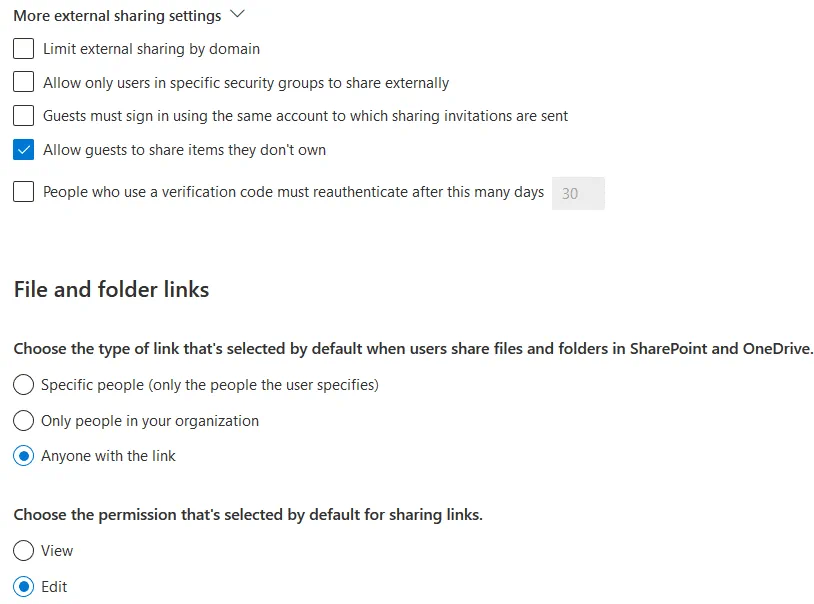
Choose expiration and permissions options for Anyone links
- These links must expire within this many days __
These links can give these permissions:
Files: View and edit/View
Folders: View, edit, and upload/View
Select the needed options in the drop-down menu.
Other settings
- Show owners the names of people who viewed their files in OneDrive
- Let site owners choose to display the names of people who viewed files or pages in SharePoint
- Use short links for sharing files and folders
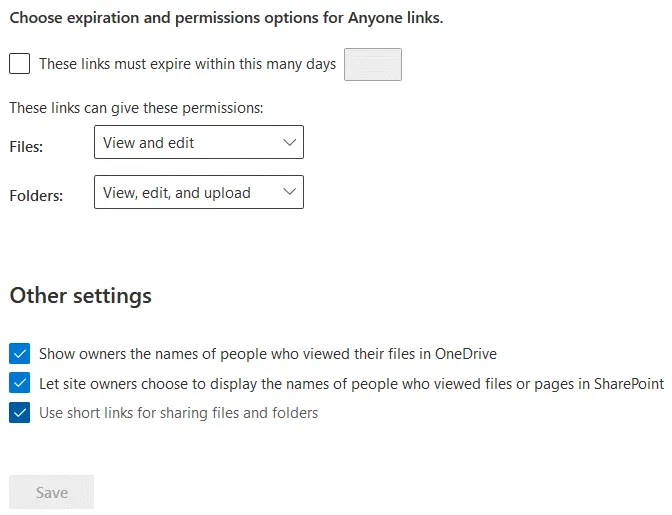
Access control
Use settings in this section to allow and restrict user access to SharePoint and OneDrive. There are four categories of options.
Unmanaged devices. You can allow, limit, or block access for devices that are not in your domain, or if specific combinations of used operating system and web browsers don’t meet the set configuration.
Idle session sign-out. This option is used for security purposes and allows the SharePoint administrator to set a period of idle time after which a user is warned and then signed out.
Network location. This option allows you to configure access to SharePoint only from trusted IP addresses. Note that when configuring this option, you have to enter your own IP address to the list of allowed IP addresses, otherwise you can block yourself.
Apps that don’t use modern authentication. This option allows or blocks access from third-party applications or old Microsoft Office applications (Office 2010 and earlier versions) that cannot enforce device-based restrictions.
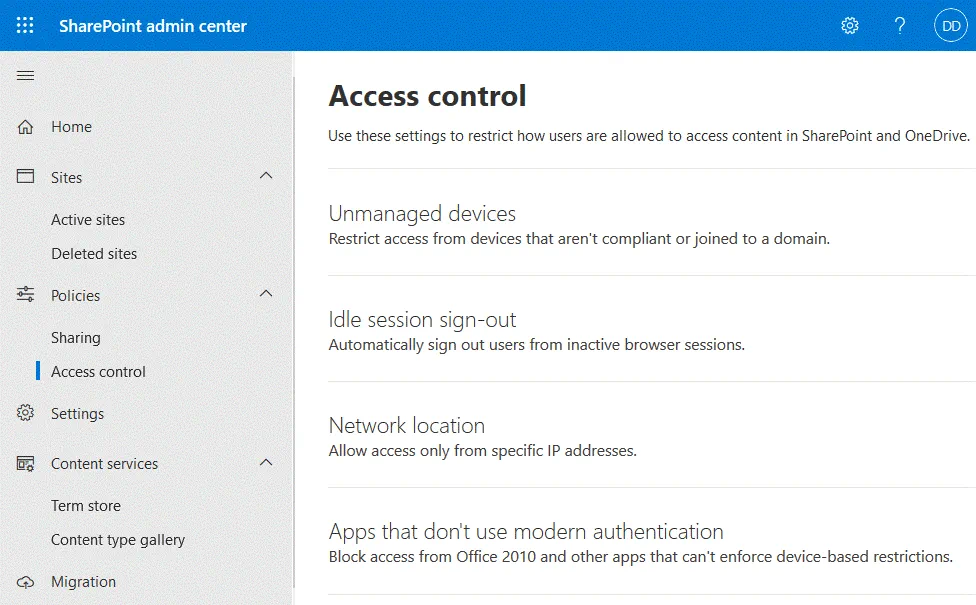
Settings
Settings for the new SharePoint admin center are located on this page.
Default admin center. If this option is enabled, a classic version of the SharePoint admin center is loaded by default when you open the admin center.
Pages. Configure whether users can create modern pages and comment on these pages.
SharePoint notifications. This setting allows users to receive notifications about SharePoint content, file activity, and news if they turn on notifications on mobile apps.
Site creation. Turn on this option to let users create sites from the start page of SharePoint and OneDrive. It is possible to select a directory where users can create sites and a default time zone.
Site storage limits. There are two options for these limits: automatic and manual. If you select the automatic option, then you let sites use as much of your organization’s storage as they need. If you select the manual option, you set specific limits for each site manually.
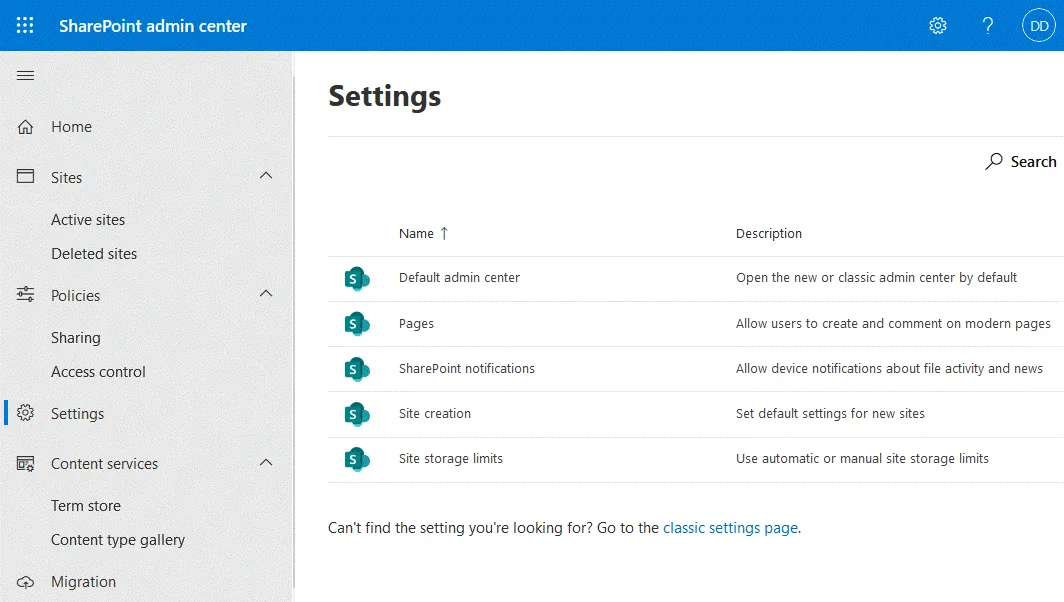
Content services
Content services help users enter data consistently and sort them by using metadata.
Term store
A term store provides more ways to store and organize data (including metadata) in SharePoint. A term store is a global site directory of common terms that you use in your organization. You can edit the local taxonomy for a SharePoint site, create and edit terms, and designate a person or group for the term set. In this case, the assigned labels don’t grant additional permissions but help you identify (track) users by a term set, for example, a job title and department. This is the formal classification in the system.
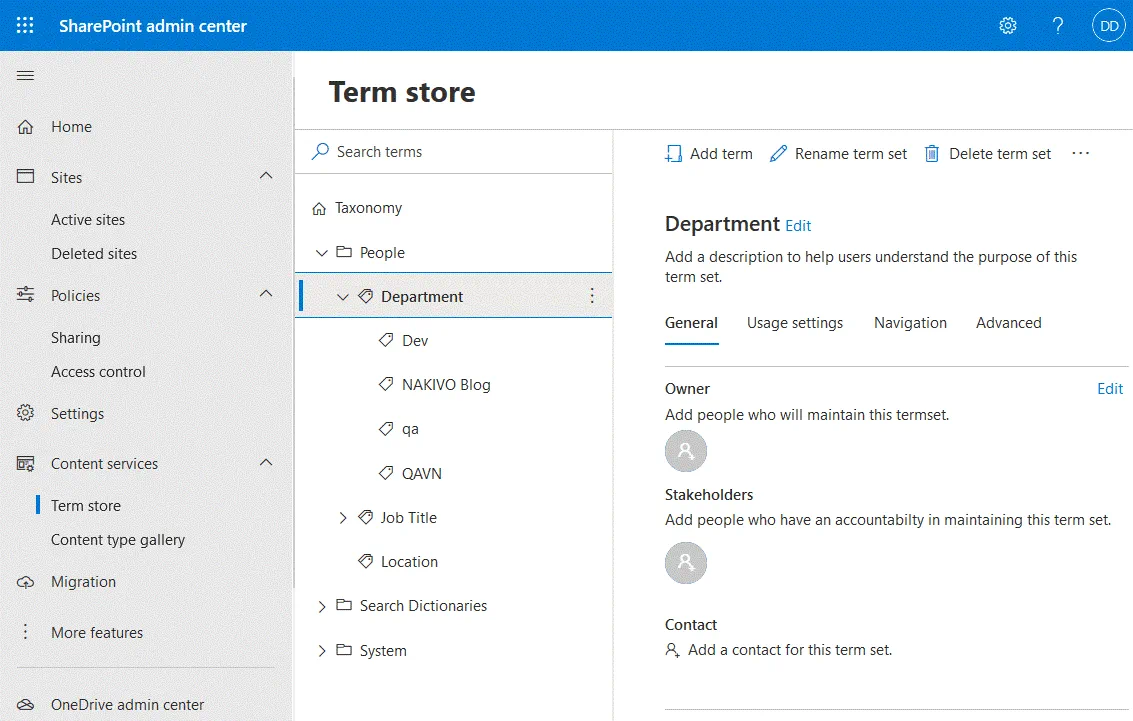
Content type gallery
Create different content types, assign a category, and associate a template with the appropriate content type. You can set configurations to make users use a standard document template. For example, when a user creates an Excel document by using a template, and the template is associated with a Timesheet content type, the user uses the correct and standardized template to create the same content type regularly.
Optionally, a content type can be added to a SharePoint list or library. A content type gallery helps you better categorize your content.
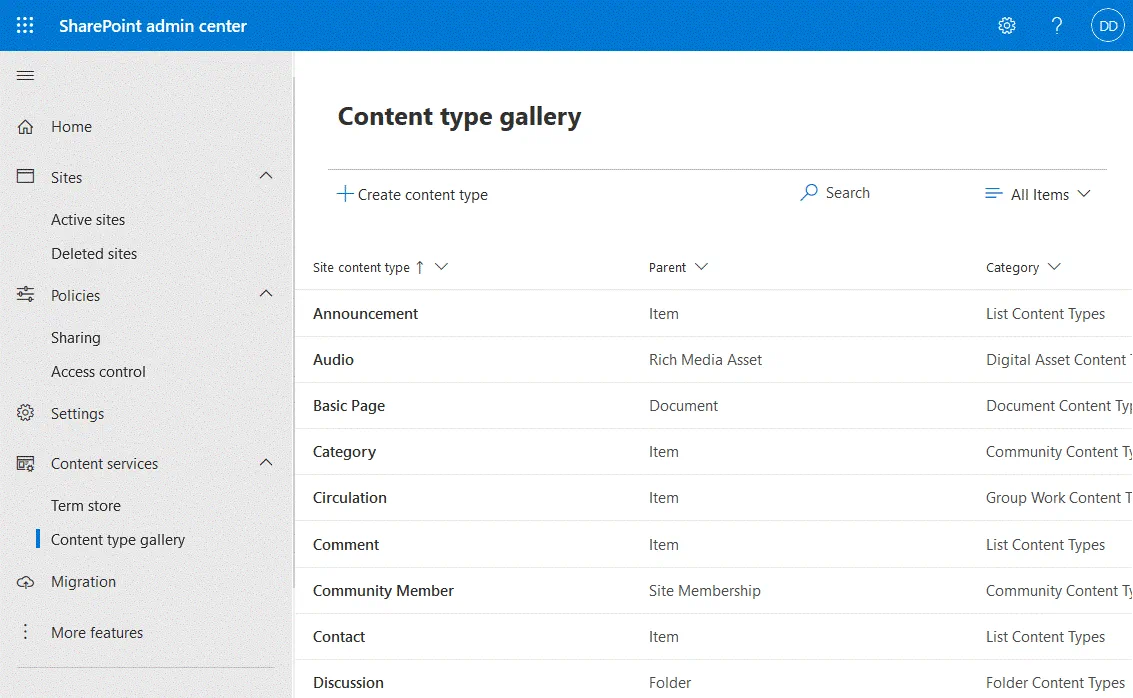
Migration
In this section, you can see options for using the migration manager and SharePoint migration tool to perform migration of on-premises file shares to Office 365 (Microsoft 365). You can copy content from a standalone SharePoint Server to SharePoint Online and Office 365.
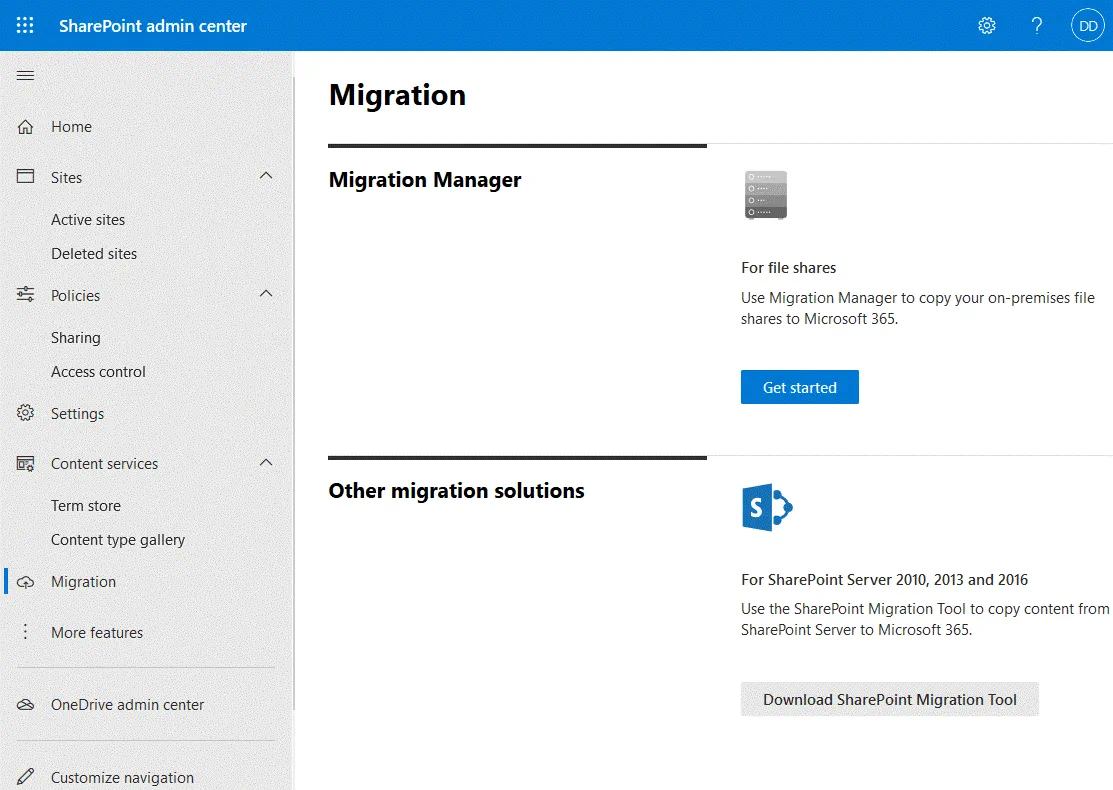
More features
On this page, you can find classic and familiar SharePoint features that were available in the classic SharePoint admin center. Select the needed feature and hit Open to access feature settings.
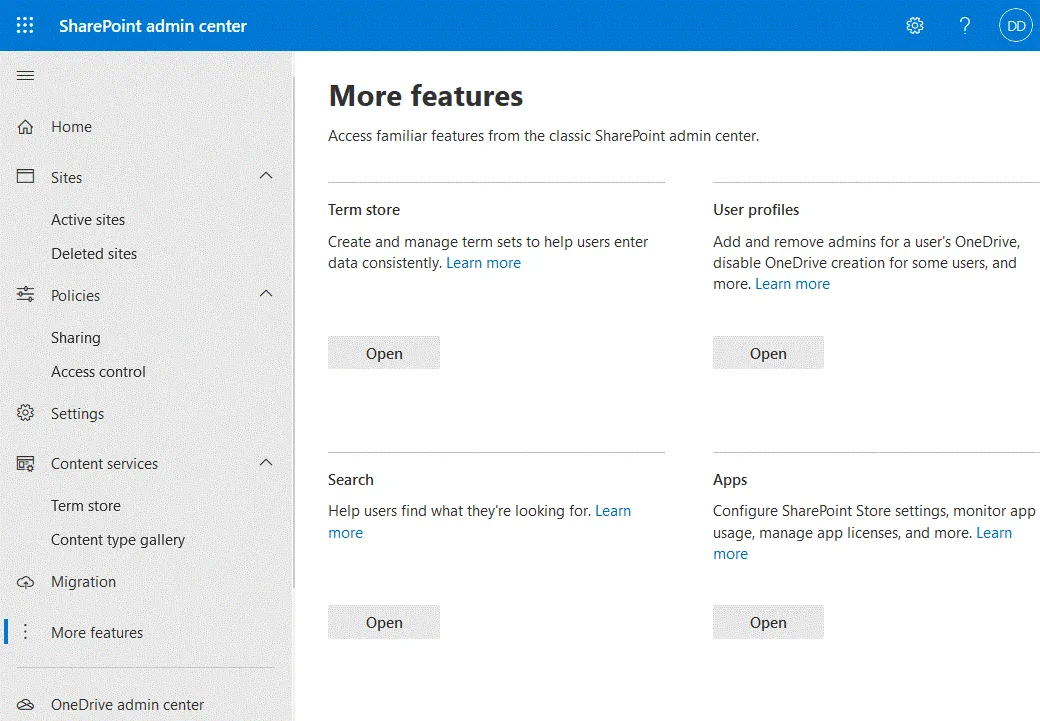
If you have not found the needed options in the new SharePoint admin center, try to use SharePoint Online Management Shell, which is available for download at:
https://www.microsoft.com/en-us/download/details.aspx?id=35588
SharePoint Online Management Shell is a set of SharePoint cmdlets that allow you to manage SharePoint Online in Windows PowerShell.
Managing Licenses
As mentioned above, a SharePoint admin center is integrated with Office 365 and the Office 365 admin center. If you need to manage user licenses in SharePoint Online, you can assign the licenses to your Office 365 users in the Office 365 admin center by going to Users > Active users. Unlike traditional versions of SharePoint Server, no CALs (client access licenses) are used for SharePoint Online.
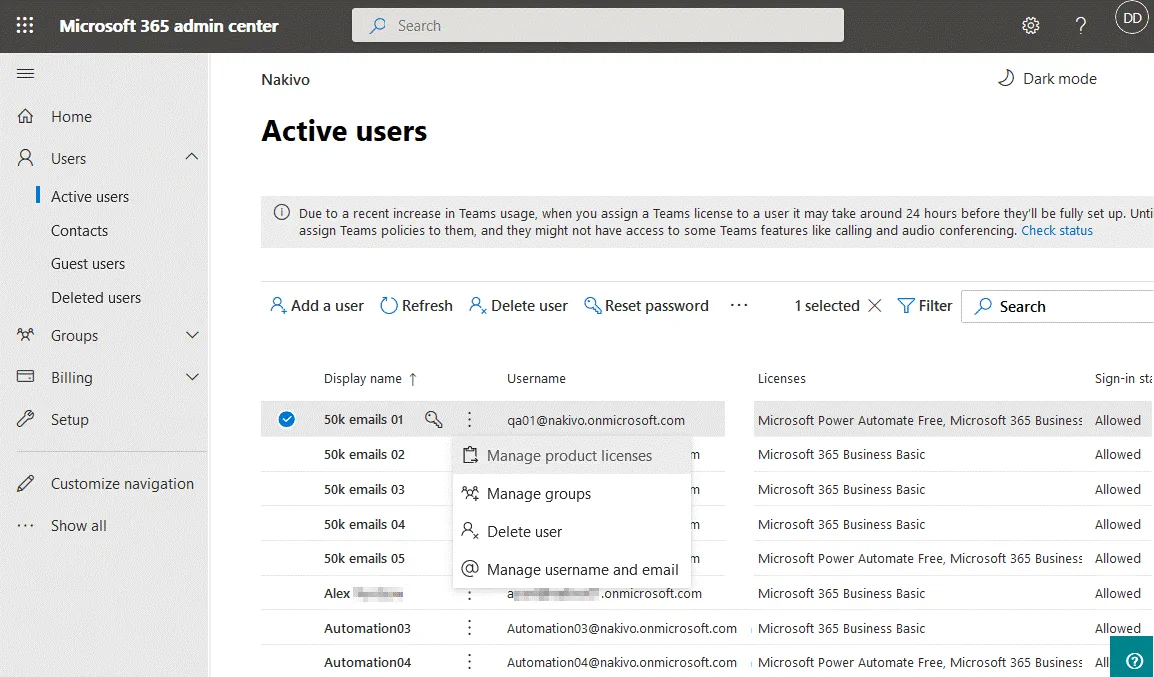
Conclusion
SharePoint central administration is used to manage SharePoint and allows system administrators to perform administrative tasks. SharePoint Online, which is part of Office 365, provides a SharePoint admin center integrated with the Office 365 admin center. It allows you to manage the Office 365 environment available for your subscription plan. You can manage SharePoint sites and content, monitor statistics, and configure sharing options, policies, and security settings in the SharePoint admin center.
You may notice that there is not enough backup and recovery functionality in the SharePoint admin center. To perform SharePoint backup regularly, use NAKIVO Backup & Replication, which is a universal data protection solution for both SharePoint Server and Microsoft Office 365 apps and services.

